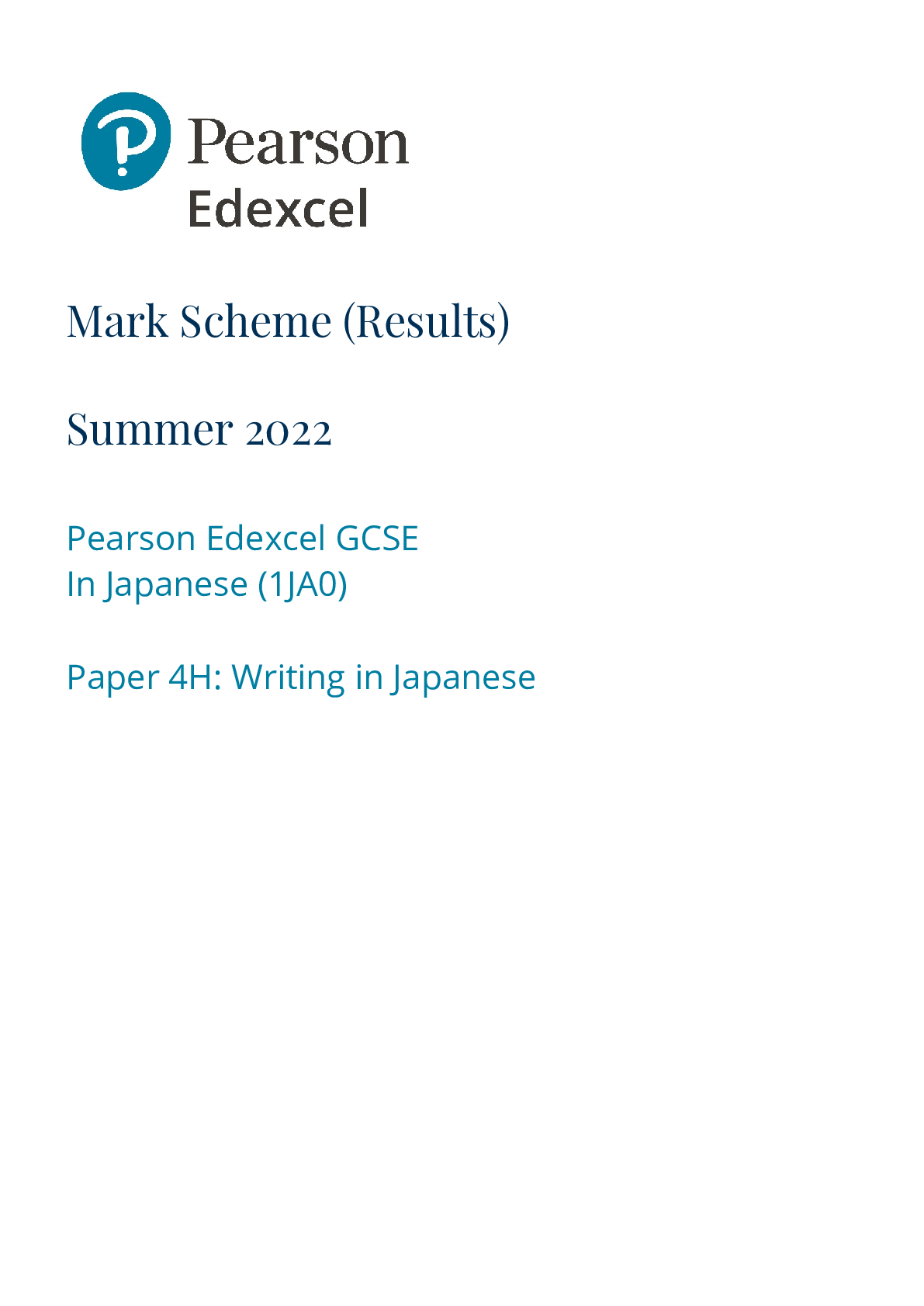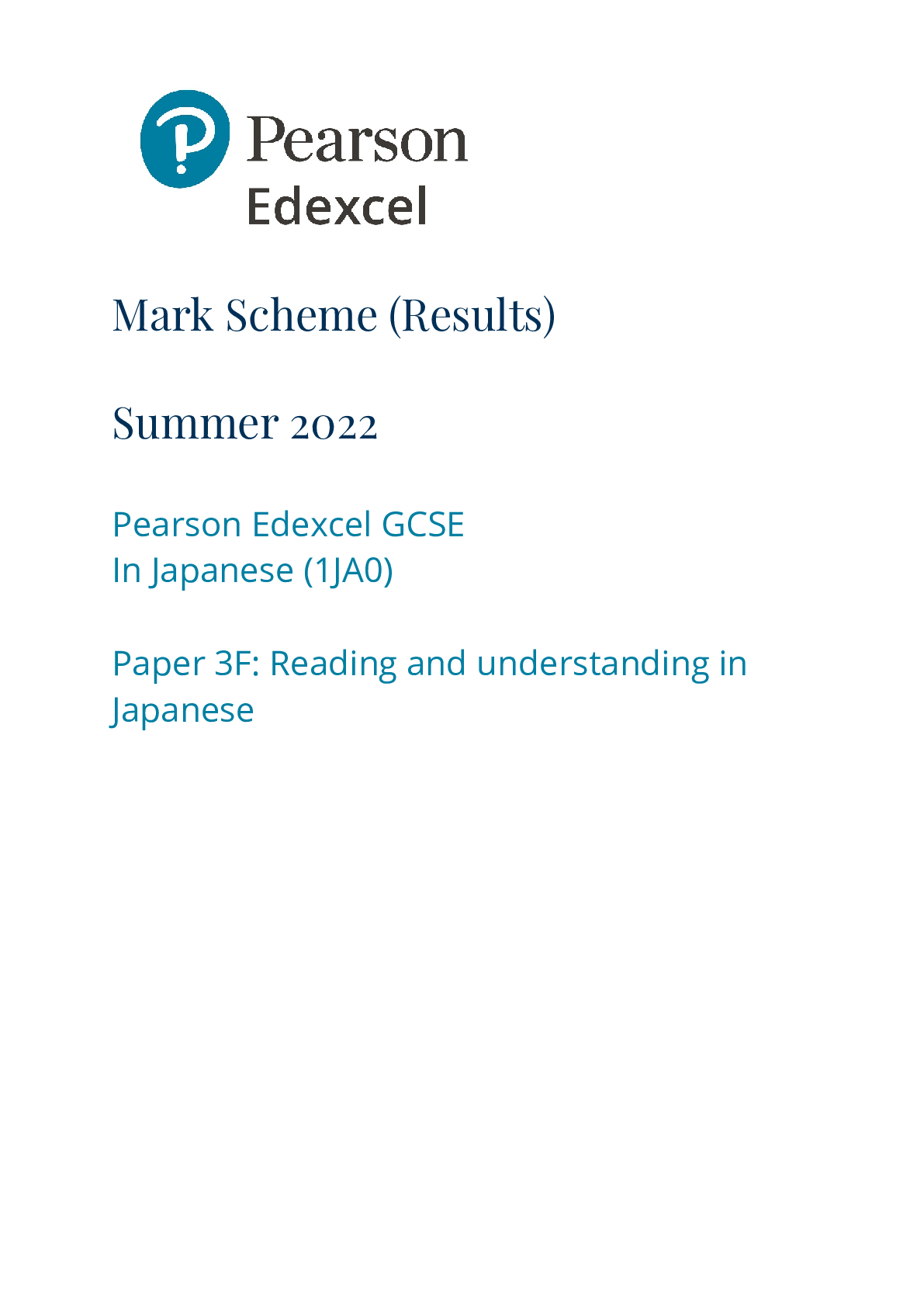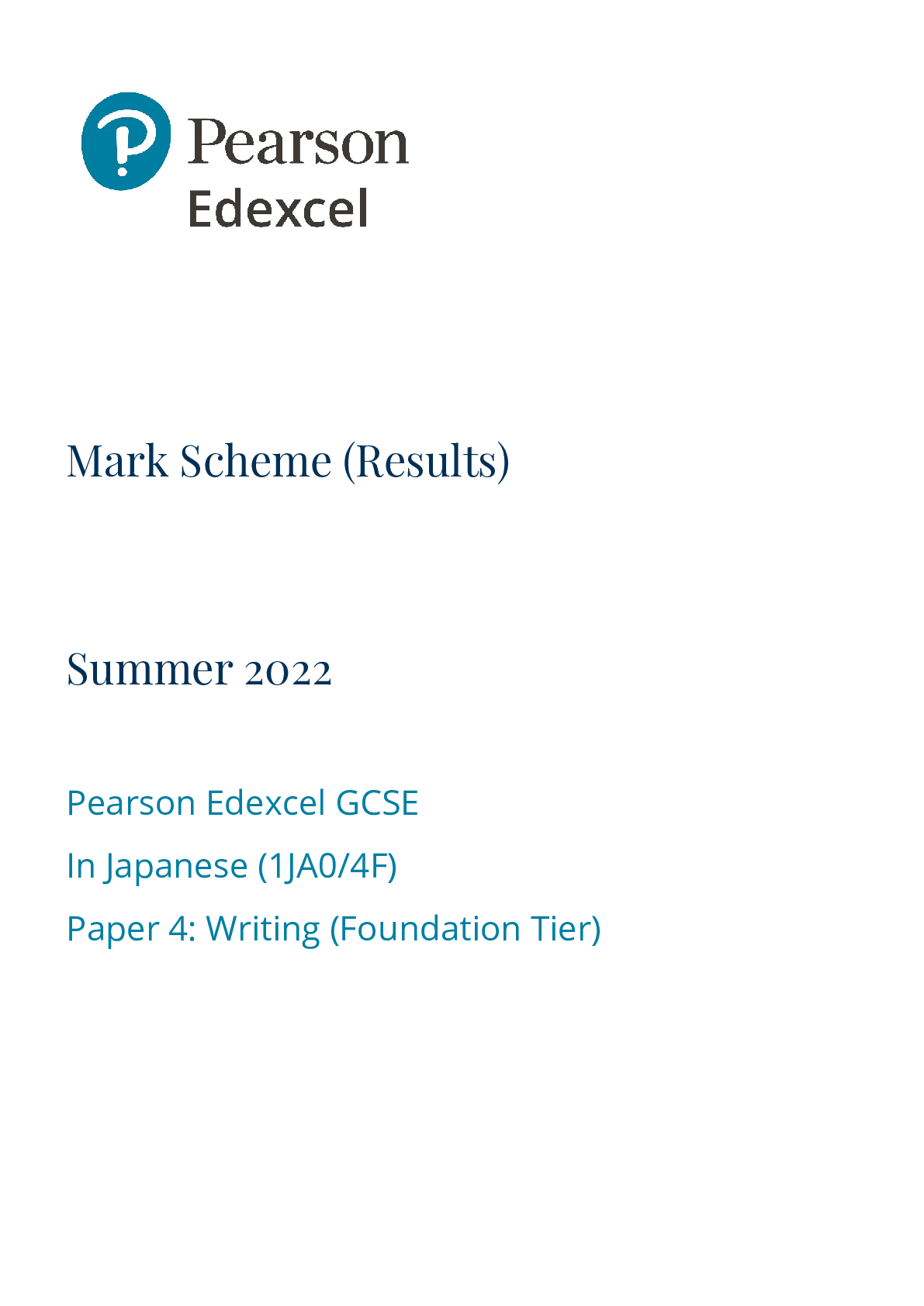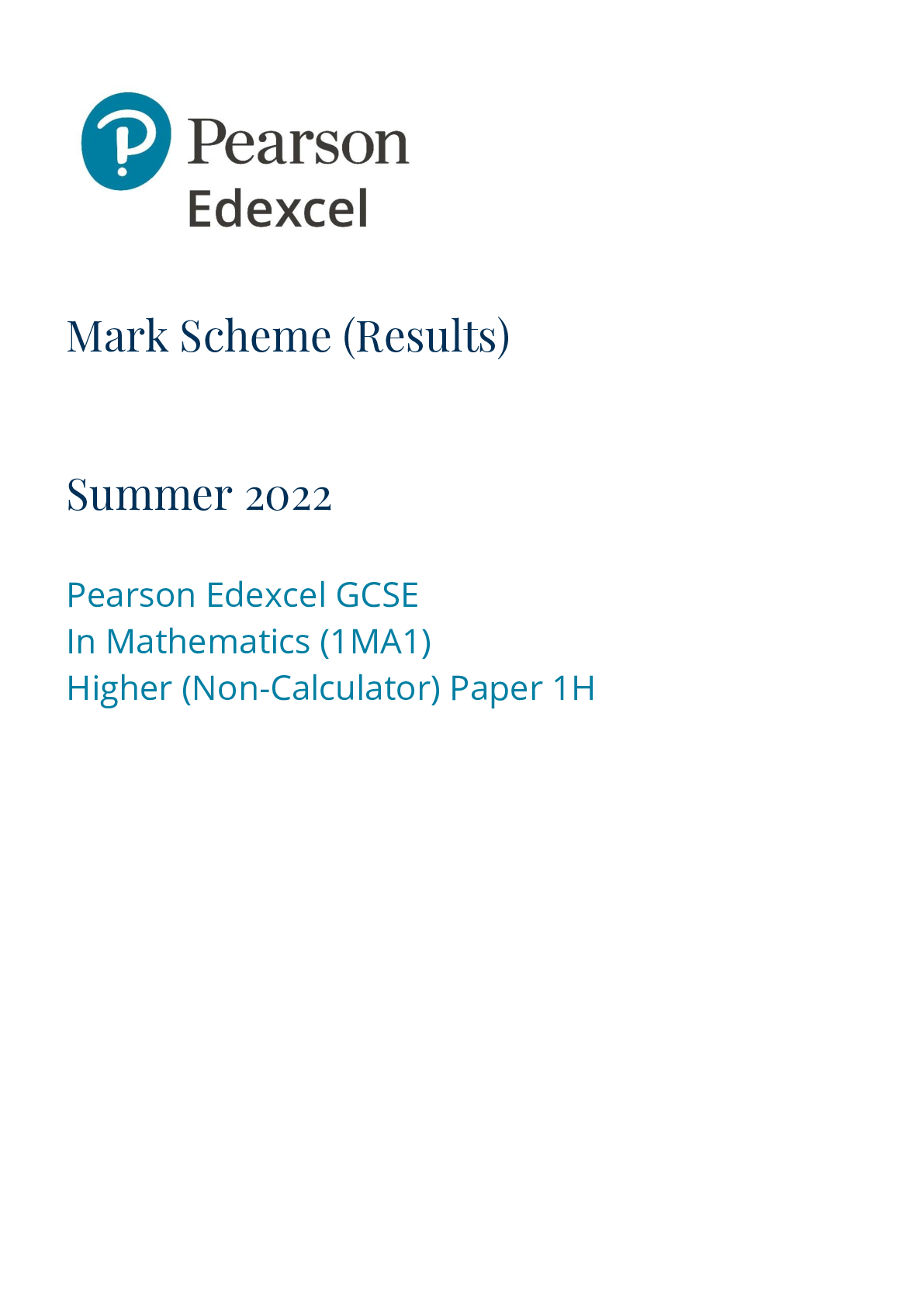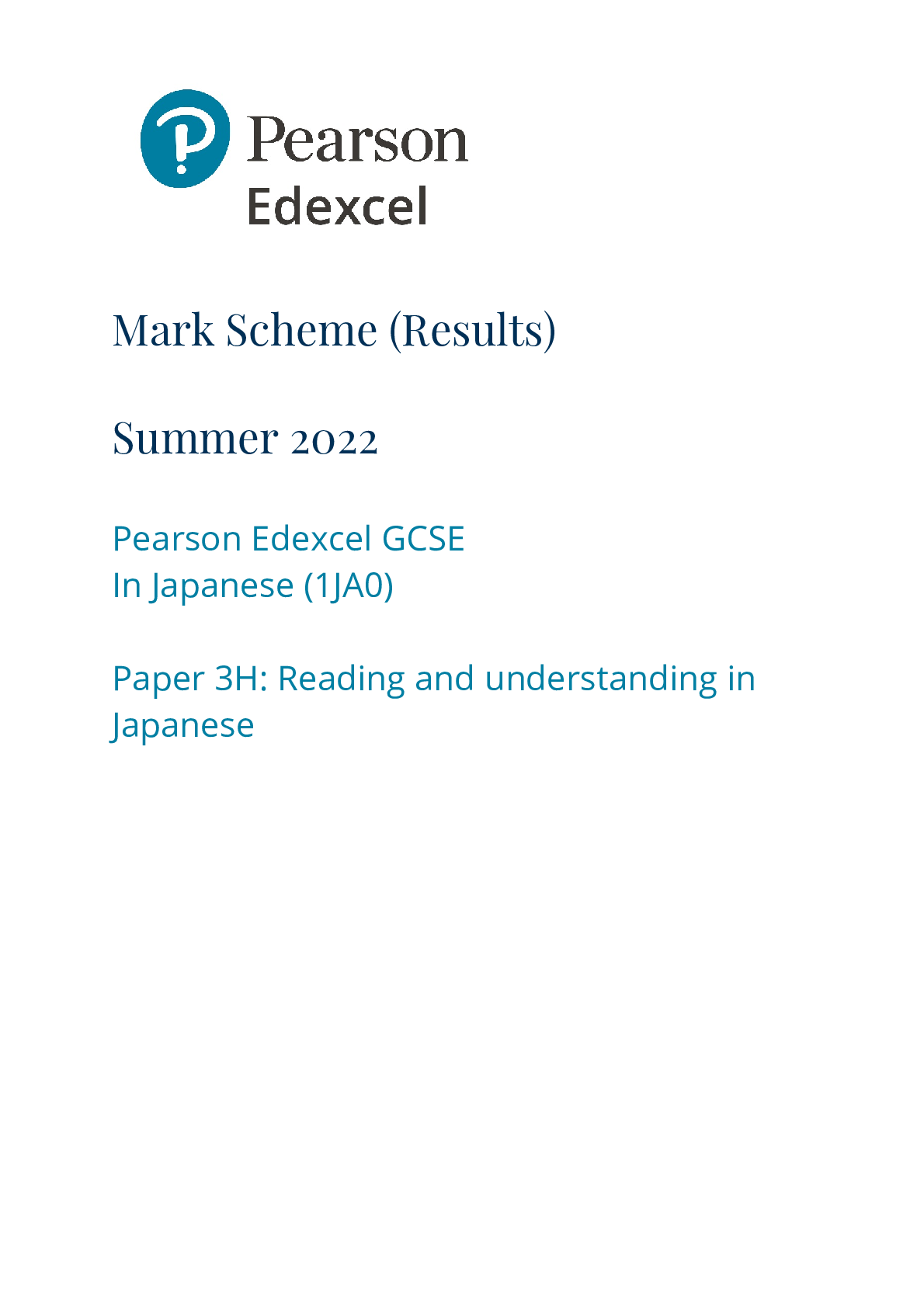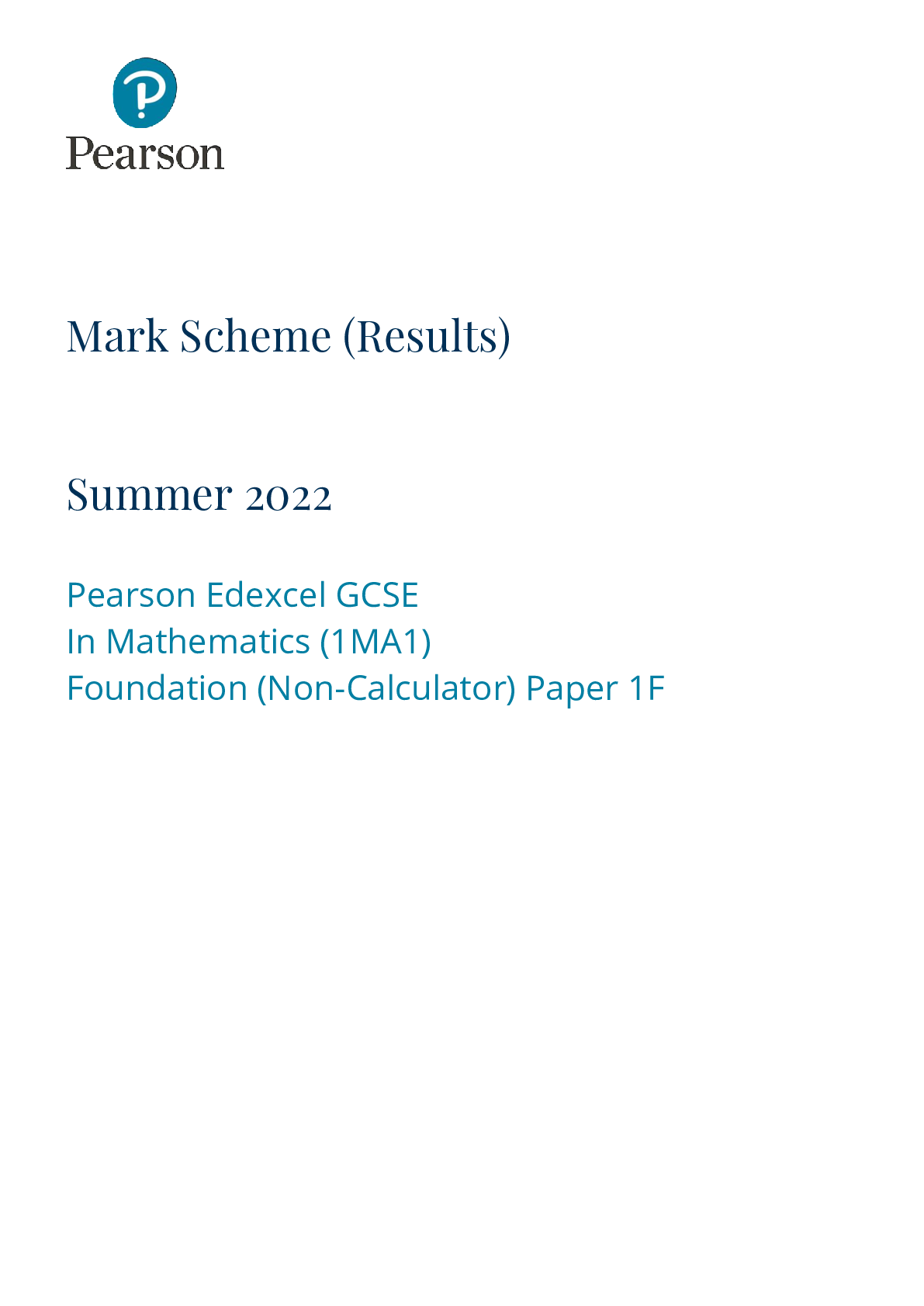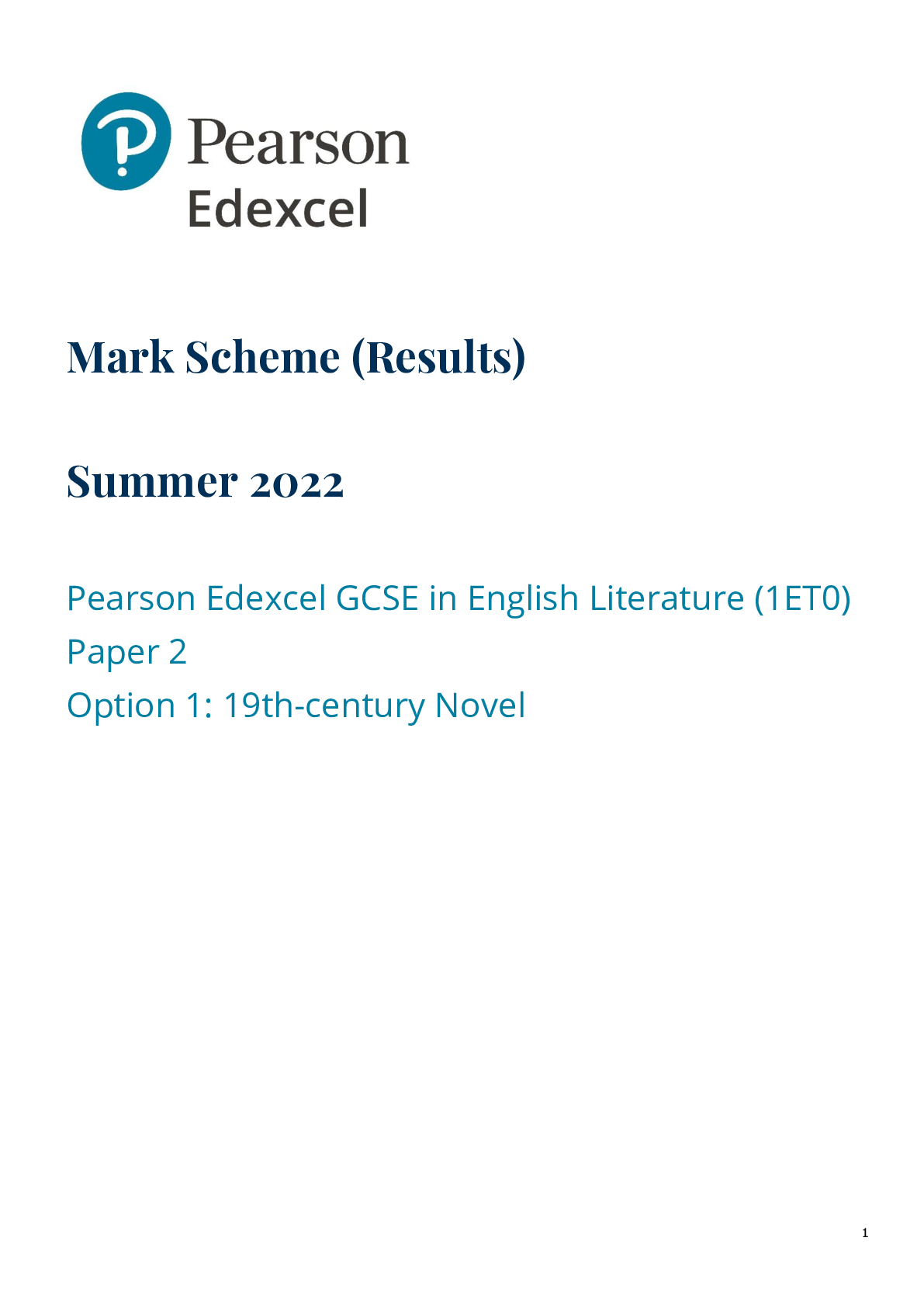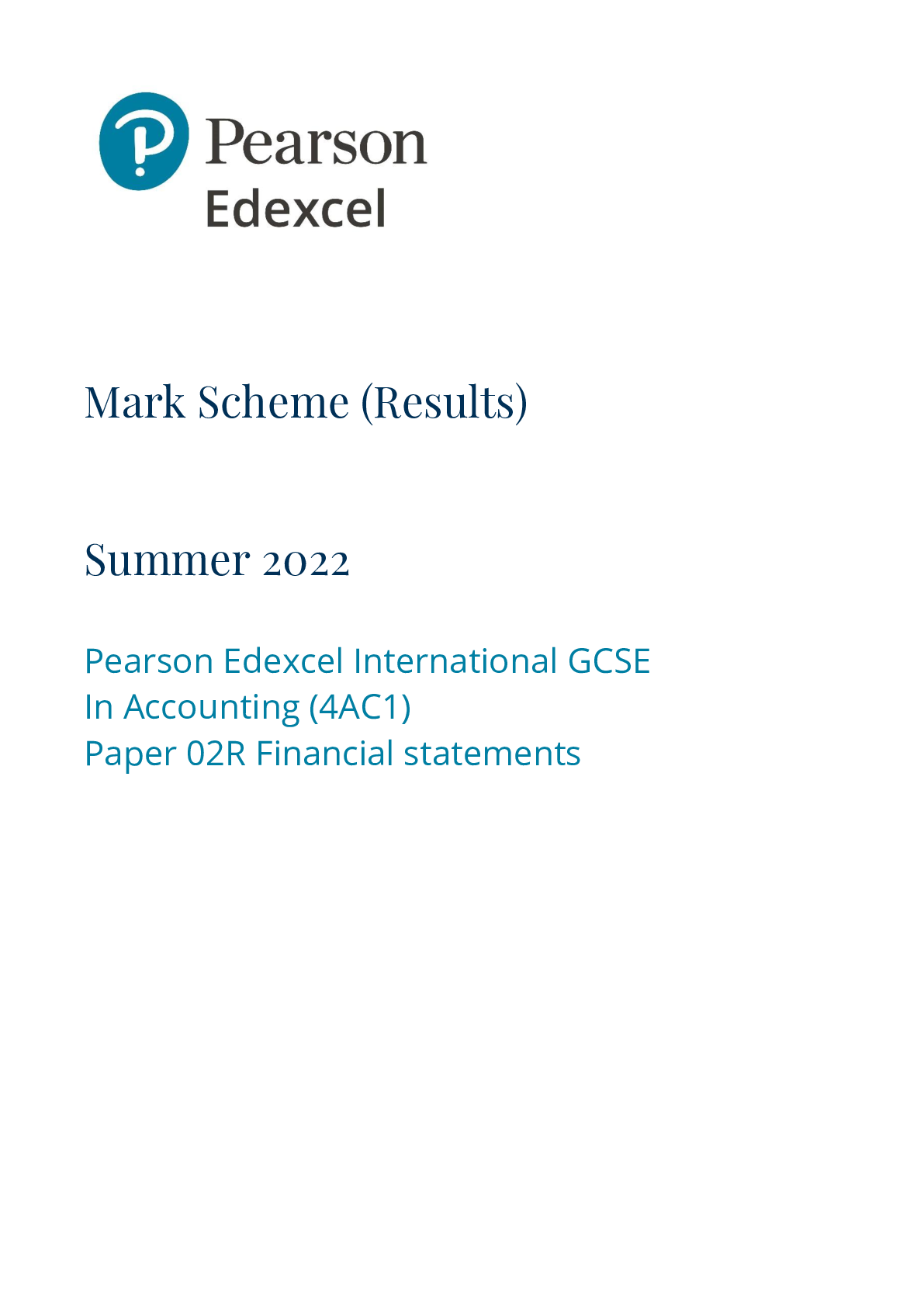Chemistry > MARK SCHEMES > Mark Scheme (Results) Summer 2022 Pearson Edexcel GCSE In Chemistry (1CH0) Paper 2F Edexcel and BTEC (All)
Mark Scheme (Results) Summer 2022 Pearson Edexcel GCSE In Chemistry (1CH0) Paper 2F Edexcel and BTEC Qualifications Edexcel and BTEC qualifications are award
Document Content and Description Below
Mark Scheme (Results) Summer 2022 Pearson Edexcel GCSE In Chemistry (1CH0) Paper 2F Edexcel and BTEC Qualifications Edexcel and BTEC qualifications are awarded by Pearson, the UK’s largest awa... rding body. We provide a wide range of qualifications including academic, vocational, occupational and specific programmes for employers. For further information visit our qualifications websites at www.edexcel.com or www.btec.co.uk. Alternatively, you can get in touch with us using the details on our contact us page at www.edexcel.com/contactus. Pearson: helping people progress, everywhere Pearson aspires to be the world’s leading learning company. Our aim is to help everyone progress in their lives through education. We believe in every kind of learning, for all kinds of people, wherever they are in the world. We’ve been involved in education for over 150 years, and by working across 70 countries, in 100 languages, we have built an international reputation for our commitment to high standards and raising achievement through innovation in education. Find out more about how we can help you and your students at: www.pearson.com/uk Summer 2022 Publications Code 1CH0_2F_2206_MS All the material in this publication is copyright © Pearson Education Ltd 2022 General Marking Guidance • All candidates must receive the same treatment. Examiners must mark the first candidate in exactly the same way as they mark the last. • Mark schemes should be applied positively. Candidates must be rewarded for what they have shown they can do rather than penalised for omissions. • Examiners should mark according to the mark scheme not according to their perception of where the grade boundaries may lie. • There is no ceiling on achievement. All marks on the mark scheme should be used appropriately. • All the marks on the mark scheme are designed to be awarded. Examiners should always award full marks if deserved, i.e. if the answer matches the mark scheme. Examiners should also be prepared to award zero marks if the candidate’s response is not worthy of credit according to the mark scheme. • Where some judgement is required, mark schemes will provide the principles by which marks will be awarded and exemplification may be limited. • When examiners are in doubt regarding the application of the mark scheme to a candidate’s response, the team leader must be consulted. • Crossed out work should be marked UNLESS the candidate has replaced it with an alternative response. Mark schemes have been developed so that the rubrics of each mark scheme reflects the characteristics of the skills within the AO being targeted and the requirements of the command word. So for example the command word ‘Explain’ requires an identification of a point and then reasoning/justification of the point. Explain questions can be asked across all AOs. The distinction comes whether the identification is via a judgment made to reach a conclusion, or, making a point through application of knowledge to reason/justify the point made through application of understanding. It is the combination and linkage of the marking points that is needed to gain full marks. When marking questions with a ‘describe’ or ‘explain’ command word, the detailed marking guidance below should be consulted to ensure consistency of marking. Assessment Objective Command Word Strand Element Describe Explain AO1* An answer that combines the marking points to provide a logical description An explanation that links identification of a point with reasoning/justification(s) as required AO2 An answer that combines the marking points to provide a logical description, showing application of knowledge and understanding An explanation that links identification of a point (by applying knowledge) with reasoning/justification (application of understanding) AO3 1a and 1b An answer that combines points of interpretation/evaluation to provide a logical description AO3 2a and 2b An explanation that combines identification via a judgment to reach a conclusion via justification/reasoning AO3 3a An answer that combines the marking points to provide a logical description of the plan/method/experiment AO3 3b An explanation that combines identifying an improvement of the experimental procedure with a linked justification/reasoning *there will be situations where an AO1 question will include elements of recall of knowledge directly from the specification (up to a maximum of 15%). These will be identified by an asterisk in the mark scheme. Chemistry 1CH0/2F Question number Answer Additional guidance Mark 1(a)(i) strong / unreactive (with water/air) / non-toxic / can be moulded allow: flexible; ignore: hard, tough, durable, won’t break allow: waterproof, insoluble ignore: Doesn’t corrode/ rust ignore: easy to make, cheap ignore lightweight and any other properties/ descriptions (1) AO1 1 Question number Answer Additional guidance Mark 1(a) (ii) an explanation linking • plastics made from (crude) oil (1) • which is {finite/ non-sustainable} (1) OR • the plastic is non-biodegradable (1) • plastic ends up in landfill (1) MP2: allow non-renewable MP3: allow: {takes a long time/hard} to {decompose/ break down} MP4: allow: {hard to/ cannot be} recycled / may give toxic fumes if incinerated ignore any reference to effect on wildlife ignore general answers such as ‘harmful to environment’ mark independently (2) AO2 1 Question number Answer Mark 1(b) B it does not react with water is the only correct answer A, C are not correct because they are not useful D is an incorrect statement (1) AO1 1 Question number Answer Mark 1(c) C the size of a few hundred atoms is the only correct answer A and B are incorrect because nanoparticles are made of more than one atom D is incorrect as there are too many molecules (1) AO1 1 Question number Answer Additional guidance Mark 1(d) • % water = 100 – 35 – 25 = 40% (1) • 40% x 150 = 60 (cm3 ) (1) 60 with no working at all scores 2 35 + 25 = 60 scores 0. with ANY working shown: MP1 – for 40(%) (do not need to show how calculated). Can be shown on pie chart. allow 0.4 or 2/5 ECF for MP2 (2) AO2 1 Question number Answer Mark 2(a)(ii) 3 / three (1) AO2 1 Question number Answer Additional guidance Mark 2(a)(iii) A description including • (the melting points) decrease (1) • as the atomic number increases/ as you go down {the group / the alkali metals / group 1} (1) allow (melting points) {go down / get smaller} ignore less heat needed to melt it MP2 depends on MP1 allow (going) down (the table / list) allow down the periodic table ignore references to boiling point higher the atomic number, lower the melting point (2) ORA higher in {group/ table} the higher the melting point (2) ORA (2) AO3 1 Question number Answer Additional guidance Mark 2(a)(i) Rb / Cs / Fr symbols must have uppercase letter then lowercase letter reject answers with any other symbols ignore any names (1) AO2 1 Question number Answer Additional guidance Mark 2(b)(i) test tube / boiling tube ignore just ‘tube’, testing tube (1) AO2 2 Question number Answer Additional guidance Mark 2(b)(ii) An explanation to include any three from: Step 2 • cut a smaller piece of sodium (1) • so less reaction / slower reaction (1) Step 3 • use a larger {container / trough} (of water) (1) • there is more water so more heat is absorbed (1) reject use powdered sodium for MP1 and MP2 MP2 is dependent on MP1 allow less sodium / smaller volume of sodium / 1(cm3 ) x 1(cm3 ) x 1(cm3 ) cube / smaller mass of sodium ignore use less cubes allow smaller reaction / it is less reactive ignore so reaction is less vigorous MP4 is dependent on MP3 allow name of larger container: beaker/ flask ignore use larger test tube / boiling tube ignore change container ignore add more water ignore add a safety screen / observe from a distance (3) AO3 3a Question number Answer Additional guidance Mark 3(a)(i) A description to include • add water (1) • shake/ stir (1) allow: solvent / liquid Ignore: acid or alkali for MP1 but can score MP2 allow: mix; ignore dissolve MP2 depends on MP1 reject whole answer if referring to melting (2) AO1 2 Question number Answer Mark 3(a)(ii) pipette / dropper (1) AO1 2 Question number Answer Mark 3(a)(iii) A aq is the only correct answer B, C and D are incorrect as the substance is a solution in water (1) AO2 2 Question number Answer Additional guidance Mark 3(b)(i) solid/ goes cloudy allow forms of solid e.g. powder/ sediment / goes milky ignore substance ignore any colours/ colour change reject answers involving fixing/ bubbles/ effervescence (1) AO1 2 Question number Answer Additional guidance Mark 3(b)(ii) bromide reject bromine allow Br- (allow br- , BR- , bR- ) (1) AO3 2 Question number Answer Additional guidance Mark 3(c)(i) potassium chloride allow KCl (must be capital K, capital C and small l with no charges) (1) AO3 2 Question number Answer Additional Guidance Mark 3(c)(ii) 11.8 (g) with or without working scores 2 • 0.2 x 4 (= 0.8) (1) • 10 + 1 + 0.8 = 11.8 (g) (1) allow 0.2 + 0.2 + 0.2 + 0.2 / 0.8 (no working needed) ECF for MP2 if 11 + incorrect mass of 4 drops (2) AO2 1 Question number Answer Mark 4(a)(i) A Heat energy is the only correct answer. B, C and D are incorrect as all exothermic reactions give out heat (1) AO1 1 Question number Answer Mark 4(b)(i) A / thermometer (1) AO2 2 Question number Answer Additional guidance Mark 4(b)(ii) beaker allow measuring beaker/ plastic beaker reject measuring cup/ jug (1) AO2 2 Question number Answer Additional guidance Mark 4(b)(iii) it is a (good heat) insulator allow would hold / trap heat / keeps heat in / doesn’t absorb heat / reduces heat loss / poor conductor allow correct comparison of heat conductivity with glass e.g polystyrene is a better insulator than glass ignore keeps temperature in / heat resistant ignore not breakable / glass is breakable ignore ‘traps energy’ alone (1) AO2 2 Question number Answer Additional guidance Mark 4(b)(iv) -2.5℃ scores 3 with or without working 16.1 – 18.6 (1) = -2.5 (1) ℃ (1) 2.5℃ scores 2 with or without working 2.5 scores 1 with or without working MP3 standalone mark ignore ‘C’ / ‘º’ alone ignore ‘deg C’ (3) AO2 1 Question number Answer Additional guidance Mark 4(b)(v) formula: NH4NO3 (1) name: ammonium nitrate (1) letters must be capitals and 4, 3 must be subscripts allow NH4 +NO3 - allow N2H4O3 ignore state symbols ignore NH4 + + NO3 - reject ammonia nitrate (2) AO2 1 Question number Answer Additional guidance Mark 5(a)(i) carbon (1) hydrogen (1) allow answers in either order ignore C and H alone (2) AO1 1 Question number Answer Mark 5(a)(ii) B a chain molecule is the only correct answer. A, C and D are incorrect because propane is a not an oxide, a fullerene or a ring molecule (1) AO1 1 Question number Answer Mark 5(a)(iii) C 44 is the only correct answer. A, B and D are incorrect because 3 x 12 + 8 x 1 = 44 (1) AO2 1 Question number Answer Additional guidance Mark 5(b) reject more than one line from each fraction (3) AO1 1 Question number Answer Additional guidance Mark 5(c) An explanation to include three from : HCl • goes red (1) • (HCl) is an acid (1) SO2 • goes red (1) • (SO2 solution) is an acid (1) all MPs are marked independently allow pink for red reject other colours for MP1 reject references to test for chlorine/ bleaching for MP1 allow hydrogen chloride for HCl allow pink for red reject other colours for MP3 reject references to test for chlorine/ bleaching for MP3 both go red/ they go red (2) for MP1 and MP3 both are acids (2) for MP2 and MP4 (3) AO1 1 AO2 1 Question number Answer Mark 6(a) B chlorine is the only correct answer A, C and D are incorrect because only chlorine is green (1) A01 1 Question number Answer Additional guidance Mark 6(b)(i) iron + chlorine → (1) → iron chloride (1) allow = for → MP1: allow iron wool/ reactants in either order/ ignore heat MP2: reject if extra products but ignore heat reject more than one arrow for both marks e.g. iron → chlorine → iron chloride if symbol equation given only allow: Fe + Cl2 → FeCl2 (2) OR 2Fe + 3Cl2 → 2FeCl3 (2) all formulae must have correct capital and small letters and subscripts (2) A02 1 Question number Answer Additional guidance Mark 6(b)(ii) chlorine allow CL / Cl / Cl2 (1) A03 2 Question number Answer Additional guidance Mark 6(b)(iii) iron = 43 and chlorine = 82 scores 3 with or without working 34.4 x 125 (1) 100 = 43 given as mass of iron (1) 125 – 43 = 82 given as mass of chlorine (1) OR 65.6 x 125 (1) 100 = 82 given as mass of chlorine (1) 125 – 82 = 43 given as mass of iron (1) one correct and one incorrect (or missing) value with or without working scores 2 allow ECF [Show More]
Last updated: 2 years ago
Preview 1 out of 31 pages
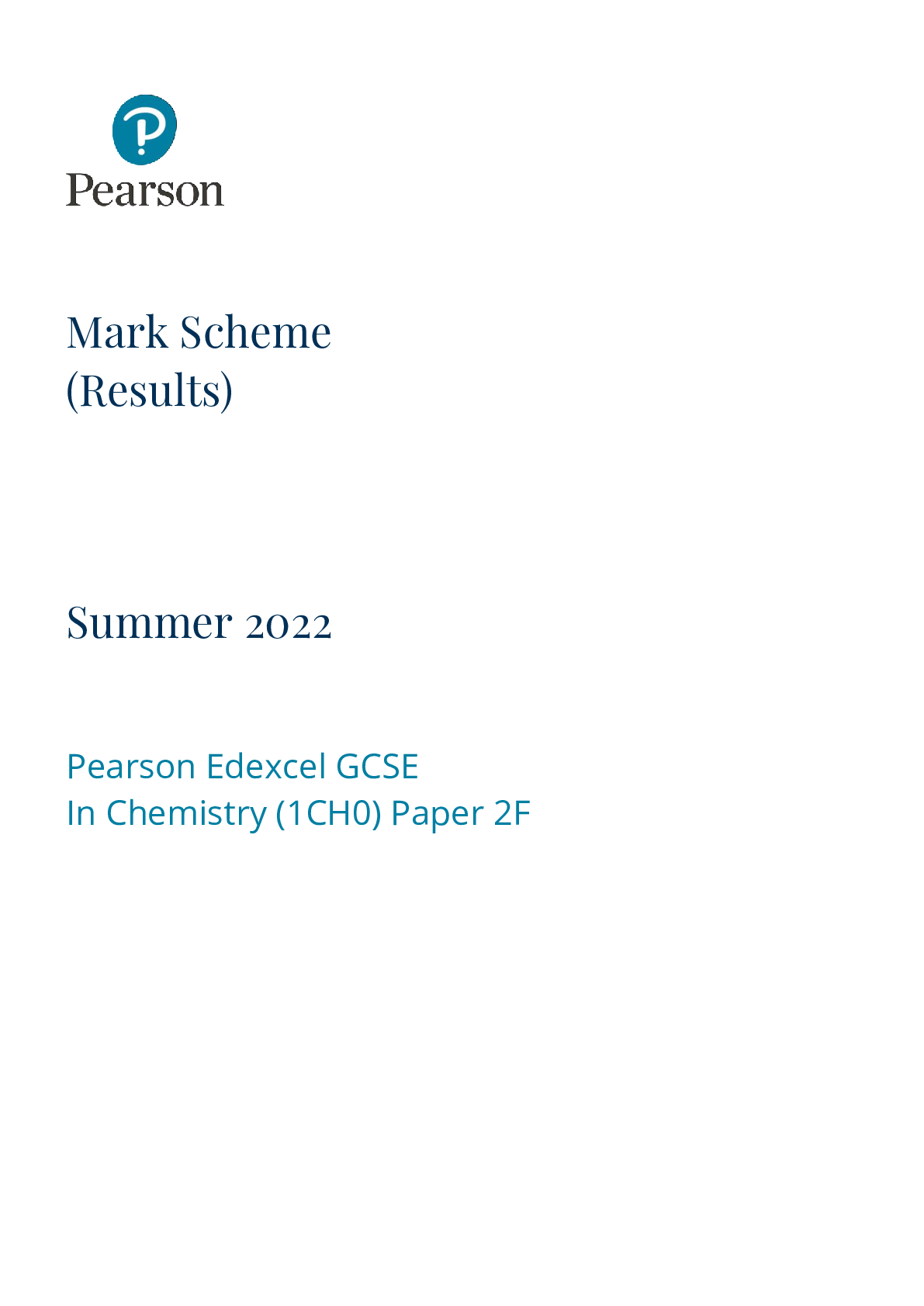
Buy this document to get the full access instantly
Instant Download Access after purchase
Buy NowInstant download
We Accept:

Reviews( 0 )
$8.00
Can't find what you want? Try our AI powered Search
Document information
Connected school, study & course
About the document
Uploaded On
Apr 03, 2023
Number of pages
31
Written in
Additional information
This document has been written for:
Uploaded
Apr 03, 2023
Downloads
0
Views
123


